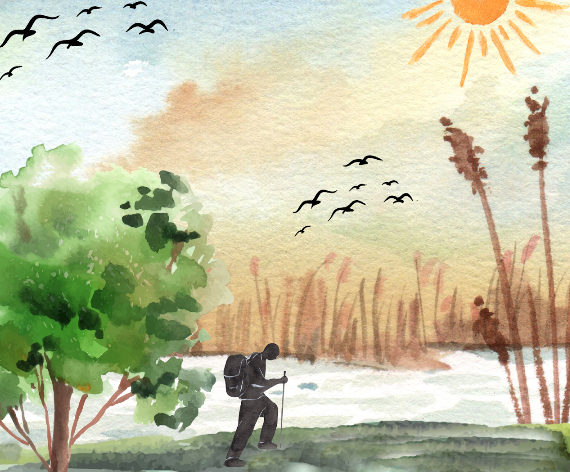
- On April 14, 2022, the University of Minnesota Sea Grant College Program hosted a one-day, virtual workshop with the goal of generating ideas and partnerships leading to targeted and impactful research funding for the St. Louis River Estuary and providing a mechanism for estuary-wide decision making.
- The workshop was composed of keynote presentations and breakout sessions where participants contributed to focused discussions.
- The workshop and outcomes directly benefit coastal management within our region by providing publicly available and accessible information needed to make estuary-wide decisions and inform the ongoing planning processes within the St. Louis River.
- Disclaimer: Many of the resources are from non-Sea Grant organizations and do not meet accessibility standards. Please contact a document's originating organization to request alternative formats.
Workshop Resources
Bird Resources
- Allouez Bay Marsh Bird Habitat Restoration.
- Hawk Ridge Fall and Spring Bird Migration Counts.
- Matteson, S.W. June 1988. Wisconsin Common Tern Recovery Plan. Wisconsin Endangered Resources Report 41, Wisconsin Department of Natural Resources, Bureau of Endangered Resources, Madison, WI. 80 pp.
- Minnesota eBird.
- Minnesota Land Trust and partners from Great Lakes Audubon, Wisconsin Department of Natural Resources, Minnesota Department of Natural Resources, and University of Minnesota-Duluth Natural Resources Research Institute are working on an estuary-wide bird conservation plan.
- For more information, contact Gini Breidenbach (Minnesota Land Trust).
- University of Minnesota-Duluth Natural Resources Research Institute Avian Ecology Lab.
- Wisconsin eBird.
Fish Resources and Tools
- 1854 Treaty Authority. Annual summary reports for St. Louis River Estuary bottom trawling survey (2011 - 2021) and 2021 Larval Sturgeon Drift Netting Summary.
- Goldsworthy, C.A.; Reeves, K.A.; Blankenheim, J.E.; and Peterson, N.R. July 2017. 2016 - 2025 Fisheries Management Plan for the Minnesota Waters of Lake Superior.
- Great Lakes Fishery Commission. Lake Superior Committee Publications and Products.
- Piszczek, P.; Nelson, A.; Wedge, M.; Varian A.; and Borkholder, B. 2016. 2015 St. Louis River Lake Sturgeon Survey Summary. Wisconsin Department of Natural Resources, Minnesota Department of Natural Resources, and Fond du Lac Band of Lake Superior Chippewa.
- Wisconsin Department of Natural Resources. 2020 - 2029 Lake Superior Fisheries Management Plan, Administrative Report No. 93. Wisconsin Department of Natural Resources, Bureau of Fisheries Management, Lake Superior Fisheries Team.
- Wisconsin Institute for Discovery and University of Wisconsin Center for Limnology, University of Wisconsin-Madison. Fishwerks.
- Estimates restoration costs to optimize fish barrier removal. Web-based GIS platform tool that targets candidate fish passage barriers to maximize habitat improvement projects and coordinate restoration efforts.
Lake Superior Headwaters Sustainability Partnership
- Website and Decision Support Tools.
- Supports partner collaboration on specific issues. Contains a mapping tool with habitat layers and a feature that will be made public in the future that is part of a metric dashboard to report out on the state of the estuary.
St. Louis River Estuary-wide Resources and Tools
- Fond du Lac Band of Lake Superior Chippewa. 2018. Integrated Resource Management Plan. Fond du Lac Resource Management Division.
- Great Lakes Coastal Wetland Monitoring Program. Central Michigan University, Institute for Great Lakes Research and collaborators.
- Site Mapping Tool.
- Data may be requested from the Natural Resources Research Institute at University of Minnesota Duluth (contact: Valerie Brady, vbrady@d.umn.edu).
- Host, George and Janet Silbernagel. 2010 - 2015. St. Louis River Estuary the Stories and the Science. Wisconsin Sea Grant Institute, Minnesota Sea Grant College Program, Minnesota Pollution Control Agency, and Wisconsin Department of Natural Resources.
- Host, George and Tom Hollenhorst. 2011. The Great St. Louis River Estuary Data Slam. Proceedings of the St. Louis River Estuary 2011 Science Summit, Lake Superior National Estuarine Research Reserve, Superior, WI.
- Lake Superior Binational Program. February 2015. A Bioconservation Strategy for Lake Superior.
- Background chapter for St. Louis and Cloquet Regional Biodiversity Conservation Plan, excerpt from A Bioconservation Strategy for Lake Superior.
- St. Louis and Cloquet Regional Biodiversity Conservation Plan, excerpt from A Bioconservation Strategy for Lake Superior.
- Minnesota Department of Natural Resources. October 2020. Habitat Restoration and Protection St. Louis River Area of Concern. Minnesota.
- Minnesota Department of Natural Resources. Watershed Health Assessment Framework.
- Minnesota Land Trust. December 2019. Nomination of the St. Louis River Natural Area to the Duluth Natural Areas Program. City of Duluth Parks & Recreation Division, Duluth, MN.
- Minnesota Pollution Control Agency.
- Environmental Quality Information System (EQuIS).
- Historical maps and photographs of the St. Louis River.
- St. Louis River Area of Concern Resources.
- St. Louis River Watershed Information, includes monitoring and assessment reports, watershed total maximum daily load reports, and other resources.
- National Oceanic and Atmospheric Administration. January 2016. Implementation Plan for the St. Louis River Estuary Habitat Focus Area.
- National Oceanic and Atmospheric Administration Natural Resources Damage Assessment and Restoration Data & Visualization Tools.
- Data Integration, Visualization, Exploration, and Reporting (DIVER Explorer) for St. Louis River.
- Staffen, Amy. 2012. Lake Superior Estuaries Annotated Bibliography. Wisconsin Department of Natural Resources, Bureau of Endangered Resources.
- St. Louis River Area of Concern Partners.
- Excessive Loading of Sediment and Nutrients Beneficial Use Impairment removal package, includes 2018 Saint Louis River Estuary Clay-Influenced Bay Assessment (Appendix 3).
- Degraded Fish and Wildlife Populations Delisting Package.
- Saint Louis River Area of Concern chemistry and biological data viewer (Tableau public).
- Story map for Minnesota and Wisconsin habitat restoration projects.
- Story map for Minnesota contaminated sediment remediation projects.
- St. Louis River Citizens Action Committee. May 2002. Lower St. Louis River Habitat Plan. St. Louis River Citizens Action Committee, Duluth, MN.
- United States Environmental Protection Agency. Lake Superior Lakewide Action and Management Plan and Associated Reports.
- Wisconsin Department of Natural Resources. 2015. 2015 - 2025 Wisconsin Wildlife Action Plan. Madison, WI.
- Wisconsin Department of Natural Resources. March 2015. Habitat Restoration and Protection Projects in the St. Louis River Area of Concern, Wisconsin.
- Wisconsin Department of Natural Resources.
St. Louis River Habitat Workgroup
- St. Louis River Estuary Habitat Work Group Google Site.
- ArcGIS Map of priority projects defined in the Lower St. Louis River Habitat Plan (St. Louis River Citizens Action Committee, May 2002).
Wild Rice / Manoomin Resources
- 1854 Treaty Authority Wild Rice Resources.
- Kjerland, T. 2015. Wild Rice Monitoring Field Guide. The University of Minnesota Sea Grant Program, Publication #SH15 (2nd ed.). ISBN 978-0-9965959-0-2.
- Kjerland, T. 2015. Wild Rice Monitoring Handbook. The University of Minnesota Sea Grant Program, Publication #SH16.
- Minnesota Department of Natural Resources. 2014. St. Louis River Estuary Wild Rice Restoration Implementation Plan. Division of Ecological and Water Resources, Duluth, MN.
- Manoomin Education and Outreach Toolkit. Wisconsin Sea Grant.
- St. Louis River Alliance Wild Rice Project and Resources.
- Taplin, C. and Wenner, K. March 2018. Potential Impacts of Orconectes rusticus (Rusty Crayfish) on Wild Rice in the 1854 Ceded Territory, Technical Report 18-09. 1854 Treaty Authority, Resource Management Division, Duluth, MN.
- Vogt, Darren J. December 2021. St. Louis River Estuary Wild Rice Restoration Monitoring (2015 - 2021), Technical Report 21-09. 1854 Treaty Authority, Resource Management Division, Duluth, MN.
Other Tools
- Great Lakes Fishery Trust. Great Lakes Aquatic Habitat Framework.
- Can be used to track projects that have been completed in the St. Louis River Estuary. Comprehensive spatial framework, database, and classification for Great Lakes basin ecological data. Housed at the University of Michigan with maintenance supported by the Michigan Department of Natural Resources Institute for Fisheries Research.
- Great Lakes Observing System. Seagull Platform.
- Real-time access to Great Lakes buoy data.
- Minnesota Department of Natural Resources. Watershed Health Assessment Framework.
- Interactive map, ecological health scores, and other resources to help natural resource managers and citizens develop a common understanding of Minnesota’s natural resource systems. Metrics look at overall health, stormwater, etc.
- Minnesota Pollution Control Agency. Impaired Waters Viewer.
- ArcGIS-based online tool that shows impaired waters of Minnesota (waters failing to meet one or more biological or chemical water quality standards).
- Minnesota Pollution Control Agency. What’s in My Neighborhood.
- ArcGIS-based online tool for searching environmental information on a wide variety of sites and facilities in Minnesota.
- National Geospatial Program, United States Geological Survey. The National Map.
- Products/services that provide access to base geospatial information to describe the landscape. Collaborative effort among USGS and federal, state, local partners to improve and deliver topographic information for the country and its territories.
- National Oceanic and Atmospheric Administration, Office for Coastal Management. Digital Coast.
- Website targeted to the coastal management community that provides coastal data, tools, training, and information. Content comes from many sources and is completely vetted by NOAA.
- Natural Resources Research Institute, University of Minnesota Duluth. Minnesota Natural Resource Atlas.
- Online mapping tools and data, including interactive map and data catalog. Has many data layers such as biota, political boundaries, and Minnesota biological survey data.
- State of Minnesota. Minnesota Geospatial Commons.
- Collaborative web space for users and publishers of Minnesota’s geospatial resources, includes environmental resources, boundaries, and transportation.
- United States Environmental Protection Agency. SteamCat Dataset.
- Contains over 600 metrics, both natural and anthropogenic, for ~2.65 million stream segments and their associated catchments across the conterminous United States.
- United States Environmental Protection Agency. EnviroAtlas.
- Provides geospatial data and other resources related to ecosystem services, chemical and non-chemical stressors, and human health. Includes 50 specific communities, and there is work to bring the community of Duluth/Superior into this platform.
- United States Geological Survey. NHDPlus HR.
- Has catchments with derived values for annual and summer flow, stream order, etc. Geospatial dataset that depicts the flow of water across the United State’s landscapes and through the stream network.
- Wisconsin Department of Natural Resources. Surface Water Data Viewer.
- Many data layers and surface water layers; ties into the Surface Water Integrated Monitoring Systems (SWIMS). Interactive web mapping tools for chemistry (water, sediment), physical, and biological (macroinvertebrate, fish) data.
Project Details
On April 14, 2022, the University of Minnesota Sea Grant College Program hosted a one-day, virtual workshop with the goal of generating ideas and partnerships leading to targeted and impactful research funding for the St. Louis River Estuary and providing a mechanism for estuary-wide decision making. The workshop was composed of keynote presentations and breakout sessions where participants contributed to focused discussions. The workshop and its subsequent outcomes directly benefit coastal management within our region by providing publicly available and accessible information needed to make estuary-wide decisions and inform the ongoing planning processes within the St. Louis River.
Project activities:
Hosted a one-day virtual workshop on April 14, 2022. Produced a collaborative resources document that workshop attendees were asked to contribute to. Produced a summary of the workshop proceedings.
Individuals and organizations working in and around the St. Louis River Estuary, including, natural resource managers, researchers, regulatory agencies, community scientists, and non-governmental organizations.
